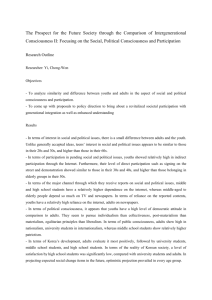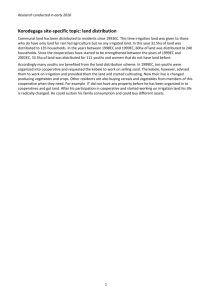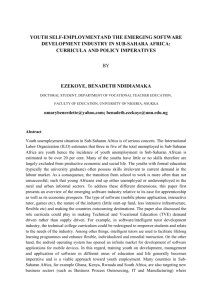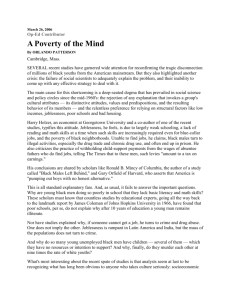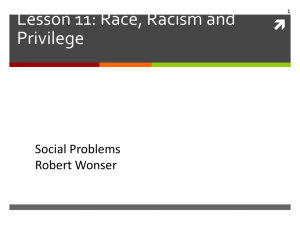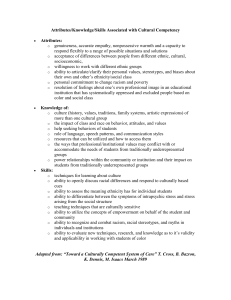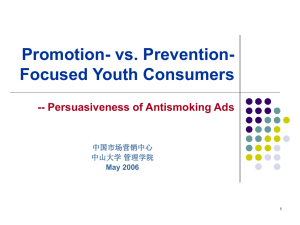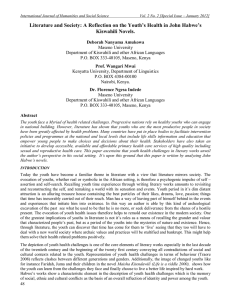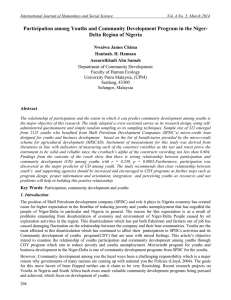Criminal Justice in Canada – Student Presentation
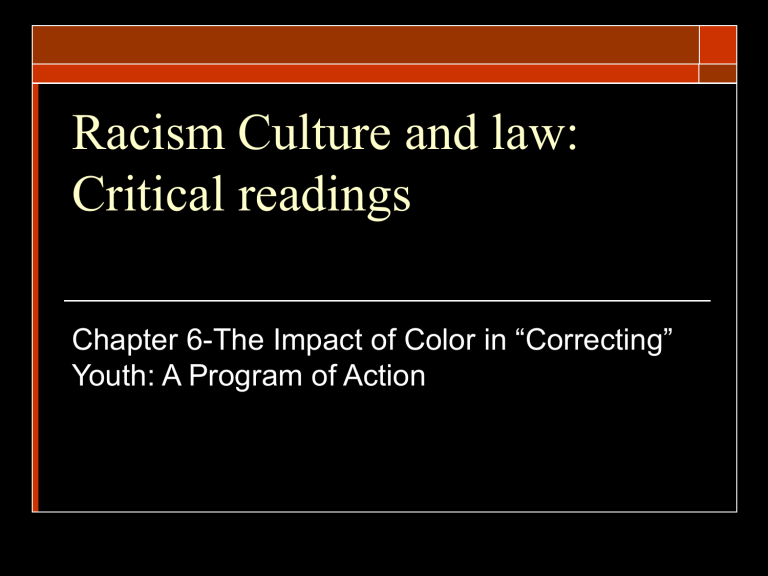
Racism Culture and law:
Critical readings
Chapter 6The Impact of Color in “Correcting”
Youth: A Program of Action
Terms
Scapegoating: the practice of singling out a group of people for unmerited negative treatment or blame.
Ghettoization: functions as a way to foster solidarity (collective conformity) among a group of people and justify exclusionary racist practices.
Racism: Ideology propagated by institutions of the criminal justice system and supported by the values within the dominant culture. These ideologies are internalized and expressed as truths.
Anti-Racist Correctional Work: Seeks for re-distribution of power and moves away from the practices of exclusion and towards principles of equity; away from the politics of superiority and towards the ethic of sharing. It moves away from professional elitism and towards community accountability.
1. Introduction
Racism
the negation of identity
a process of criminalization
not an incidental element of the social order within institutions at the very heart of political, cultural and economic conditions experienced by minority youths is an ideology, not simply of differences, physical or cultural, but an ideology of superiority that denies the meaningful participation of Black youth, for example – it disarticulates and impoverishes human beings; in essence it is an act of violence
1. Introduction (cont.)
Criminal Justice System
institutionalizes inequality with its colour-crime connections
rooted in wider hegemonic cultural controls promotes popular beliefs and common sense notions about the colour of crime that saturate media discourses and current legal logic
there is ample evidence of cultural annihilation in every stage, from the arrest, to the pre-trial hearing, conviction, sentencing, classification and parole hearings the prevailing institutional ideologies within correctional facilities incorporate strategies that compel youths to abandon distinctive ethno-cultural traits in favour of widely held dominant Anglo-
American values prevents youths from fully developing citizenship, contributes to low educational outcomes, high unemployment, low self-esteem, antisocial behaviour, family turmoil and high recidivism instead of graduating school, minority youths are assigned to prisons
1. Introduction (cont.)
Argument of Chapter
find links between racism and youth in corrections
show how institutional/administrative practices are shaped by internal and external process which contribute to alienation, powerlessness and exclusion of minority youths investigation of the differential treatment of youths, youth-staff relations, the delivery of services and specific issues relating to separation, racism, ghettoization, and access
investigates the experiences of
Black youth in “correctional” facilities
2. Literature
the policing of Black communities reflects historical and colonial attitudes towards Blacks criminalization results in the misrepresentation of Blacks as both victims and offenders high arrest rates are attributable to racial inequality that creates discriminatory conditions police officers routinely stop and interrogate Black youth on the basis of unsupportable, “suspicious” evidence
African Americans constitute a disproportionate representation of prison populations
2. Literature (cont.)
Blacks are more likely to be arrested and discriminated against in probation reports judges act with impunity in enforcing the culture of white superiority
African American youths received more severe penalty outcomes than White youths this is because of stereotypes associated with drugs, alcohol, gang involvement, etc. that influence judges judges also feel that black youths may be poor subjects for rehabilitation the criminal justice system has always been ill responsive to young black youth and black youth continue to be overrepresented
2. Literature (cont.)
in 2004
4,919 black male prison and jail inmates per
100,000 black males in the US
1,717 Hispanic per 100,000
717 White per 100,000
609, 690 young black men are under control of the criminal justice system
436,000 are in college
½ of black men are likely to be arrested during their lifetime
¼ of black men between the ages of 20-29 is incarcerated, on probation, or parole a black man Is 7.5x more likely to be arrested then a white man in California, five black men are behind bars for each one in university one out of twenty Americans born this year will serve time in prison
1990s, Ontario
black prison admission rate of 3,686 per
100,000
Aboriginal rate 1,993 per 100,000 white rate of 705 per 100,000
Afro-Caribbean youths make up 29% of youth custody orders
32% of those receiving remands were for
Blacks average sentence of White prisoners was nine months, West Indian/African twelve months,
Asians 11 months
3. Findings
They discovered that black youth were being degraded in these facilities
They were seen as “incorrigible” and “far gone” and staff refused to rehabilitate them
They were seen as ungrateful because of the misconception of how they were treated
White staff would ridicule them on their accents and claim they weren’t speaking English they would be mocked or interrupted during phone conversations with taunting of “speak English”
also Vietnamese, Chinese, Hispanic,
Somali and other youths who did not even speak an “accented” English as their first language were forced to
3. Findings (cont.)
65% of youth were reported admitting apologetically that they could not speak
English
Youth were discouraged from having any sense of culture or individuality they were not permitted to; o Speak in a different language o Where colours clothing o Have culture inspired hairstyle o Watch certain T.V. programs
Black youth were punished for wearing their clothes baggy
Staff stated that the style promoted aggression and violence
Staff indulged in the typical stereotypes
-they would use racial slurs and promote self-hate among youth
3. Findings (cont.)
Youth were commonly forced to act out stereotypes to amuse staff as blackmail for certain privileges youth found their selves having to regally behave according to these stereotypes to survive.
Black youth claimed that abuse of power by staff kept youth powerless and fearful
They reported that institutional rules were often manipulated
Physical fights of black youth were intentionally ignored by staff
Despite everything there was a sense of unity among the majority of the youth but staff discouraged relationships with inmates
3. Findings (cont.)
In this section it was clear that: o There was a need for racial minority staff o Racism is prevalent o The service delivery system is frustrating o Administrative and bureaucratic rules are confusing o And the penal institutions have done very little or noting at all for the poor treatment
Black/racial minority youth
4. Institutional/Organizational Findings
Correctional institutions give little to no attention to bring about change to existing barriers.
Major gaps were revealed in the information base of staff regarding cultural and racial characteristics of their clientele as well their own workforce. Along with this, there are also great inconsistencies in the delivery of services for youth in all institutions.
Institutions are unwilling to share information or data regarding the cultural and racial characteristics of their clientele, staff and volunteers.
Many Black/racial minority volunteer programs that deliver culturally specific and supportive programs are consistently harassed by management and correctional workers.
4. Institutional/Organization Findings
(cont.)
Youths from visible racial and cultural groups face problems which are common with other residents but become a large issue for them since they are not well aware of their rights and entitlements and also due to language barriers.
Cultural differences make them more susceptible to misconceptions and negative judgments.
Black youths noted that cultural barriers lead to issues such as lack of respect by the staff of religious practices. This was a wide spread complaint amongst
Christian and Muslim youths.
Many Black youth face drug tests after being visited by family members where as white youths were seldom tested for drugs after their temporary release.
5. A Programme of Action
When it comes to taking action,
Robert Perlman states that the behaviour of providers of access to services is mainly bounded and shaped by the need to be economical in the use available resources.
Access involves two components: client access and organizational access
New rules of conduct within cultures of accountability, equality and authentic communities are extremely necessary to bring about change.
6. From the Exclusion of Conclusions towards the Introduction of Inclusions
to solve these problems of the justice system, we must create rules of conduct within cultures based on accountability, equality and authentic communities we must also question not only the justice system but also ourselves as to what changes need to made and how to implement them
Videos
http://www.youtube.com/watch?v=2QN_WU
AHuI8
http://www.youtube.com/watch?v=16qpnKyf
0xg
Questions
1.
2.
3.
4.
5.


